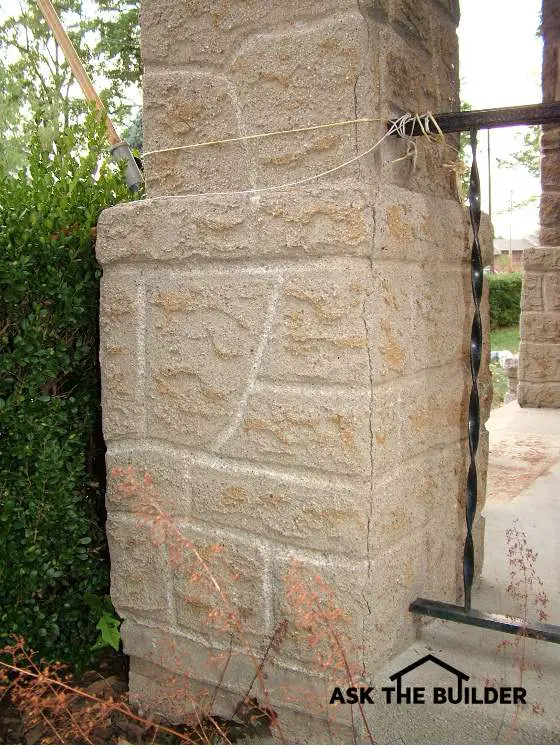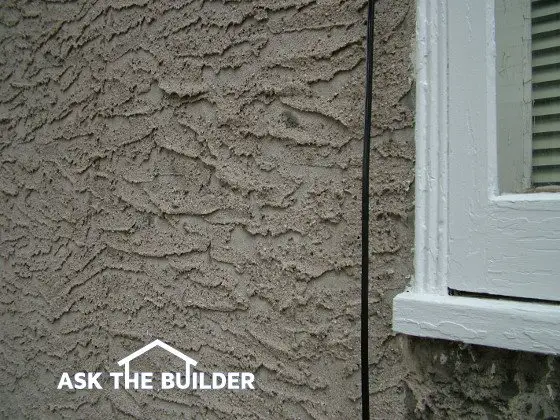Applying Stucco

This pillar looks like stone, but it is stucco. The master craftsman who made it took the time to shape the stucco to make it look like rock with mortar joints. PHOTO CREDIT: Tim Carter
DEAR TIM: Can you apply stucco to the exterior of a brick home? I have a small one-story ranch home. A friend of mine says this is not possible, but I am determined to learn how to stucco my own home. Is applying stucco a difficult task? Are there certain stucco textures I should avoid? What tips can you share to ensure the stucco does not peel off the house? Gaynell M., Austin, TX
DEAR GAYNELL: Good news! You can have stucco applied to your brick home. What I can't answer is whether or not you possess the skills to apply exterior stucco. Not only do you need hand-eye coordination, you will need certain tools and equipment. These challenges are not insurmountable, but they can create issues. You can rent the needed scaffolding and a powered mixer that will be required for this job.
Brick, concrete block walls and even poured concrete walls are excellent surfaces to stucco. It is a common practice to stucco exposed poured-concrete foundations to mask the irregularities created by the wood or metal forms. Stucco also does a splendid job of hiding mortar joints in concrete-block walls.
The first thing to do is to inspect your existing brick. It must be in good condition, clean, and free of all dust. Now is the time to correct any water-infiltration issues. If flashings above or below windows and doors are inferior, you want to correct these issues now. There are many wonderful stucco manuals and guides that show how to install flashings around windows and doors.
Applying stucco is almost always a two-step process. You typically apply a base or scratch coat that is approximately 3/8-inch thick. The stucco mixture is a combination of clean sand, masonry cement and Portland cement. Masonry cement is often a mixture of Portland cement and hydrated lime. You will discover that if you mix one part Portland cement plus one part masonry cement with eight parts of clean, damp medium sand, you will get a splendid base stucco mix. The same proportions can be used for the finish coat of stucco.
Before you start to apply the stucco to your home, I suggest you practice first. You can do this by building an 8-foot wide by 8-foot wide wall from 2x4's. Cover the studs with 1/2"-inch-thick cement board. It is important that you get comfortable with the tools and techniques of applying the stucco.
Be sure this temporary wall is secured well so it does not tip over or is blown over by the wind. Once you feel proficient, then consider starting outdoors on the walls of the house you rarely see or can't be seen from the street. You want the most-visible walls surfaces to be stuccoed last after you have discovered how to do a great job. Don't worry about perfection when working with the base coat, since it will be covered with the finish coat. You want the base coat to be somewhat rough so the finish coat bites into it.
Prior to applying the base coat of stucco, be sure to get the brick wall damp by misting it with a hose. The brick you cover with stucco should always be damp just before it is coated. Try to avoid working on hot, dry windy days. The best conditions to apply stucco are on overcast days with the temperature in the 50-60 F range. Since you can control when the stucco is applied, do not apply any stucco if the temperature will drop below 32 F within days of applying either the base or finish coat of stucco.

Stucco textures are as varied as plants in a forest. This texture looks like it did the day it was installed in 1916. PHOTO CREDIT: Tim Carter
One of the best aspects of stucco are the infinite types of textures you can create. I don't know that there are any I would avoid, although I would try to do a texture that is a simple two-step process. When you apply the finish coat of stucco, try applying it in a random fashion and then overlap the different strokes slightly. The finish coat of stucco should not exceed 1/4-inch in thickness.
Experiment with different textures on the temporary wall where you learned how to apply the base-coat stucco. Stand back from the wall about 30 - 50 feet to see what it will look like from the street. All too often stucco rookies think a texture looks great as they apply it, but the relief and texture disappears when you stand back from the wall surface. Look at the texture at different times of day, especially if you want a rough texture that creates shadows.
The biggest challenges one faces in a do-it-yourself stucco job is mixing the stucco and getting it to the work location. To get professional results, the person applying the stucco needs to be fresh and concentrating on applying the material, not worn out from mixing and wheelbarrowing stucco mix around a jobsite. If at all possible, try to arrange for a helper.
To ensure both color and texture match, all materials for the job should be purchased at the same time. Sand purchased from two different suppliers can be very different in both color and particle size. If you run out of sand part way through the job, you may not be able to get matching sand. This is not too critical with the base coat, but it is imperative you use the same sand on the finish coat.
Portland cement and masonry cement can also be slightly different colors. Buy enough material for the entire job and keep the cement in a garage where there is no risk of getting wet from the rain.
Column 696
19 Responses to Applying Stucco